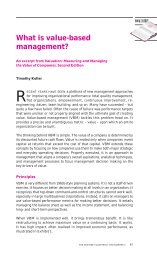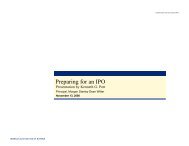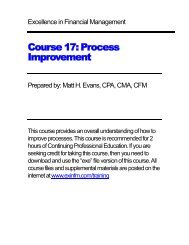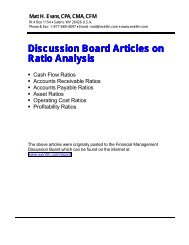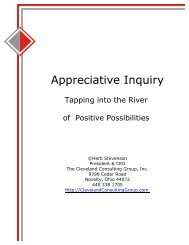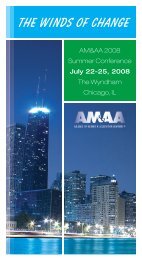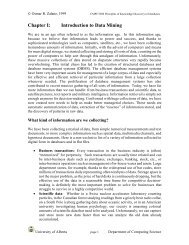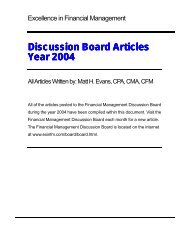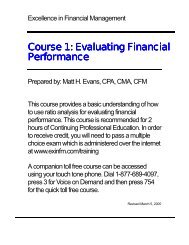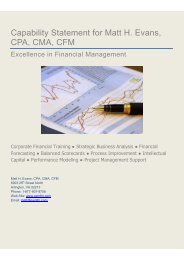Short Articles (PDF) - Excellence in Financial Management
Short Articles (PDF) - Excellence in Financial Management
Short Articles (PDF) - Excellence in Financial Management
Create successful ePaper yourself
Turn your PDF publications into a flip-book with our unique Google optimized e-Paper software.
Example: We have a project with an <strong>in</strong>itial cash outlay of $ 40,000 and cash <strong>in</strong>flows<br />
each year are $ 10,000 over the next five years.<br />
$ 40,000 / $ 10,000 = 4.0 factor, look up the 4.0 factor under Present Value of<br />
Annuity Table, across for periods = 5, we f<strong>in</strong>d 3.993 under 8%. The Internal Rate of<br />
Return is approximately 8%.<br />
Us<strong>in</strong>g Microsoft Excel Spreadsheet: Enter all cash outflows and <strong>in</strong>flows <strong>in</strong>to cells A1<br />
to A7: - 40000, +10000, +10000, +10000, +10000, +10000. Make sure you enter<br />
your amounts <strong>in</strong> the correct order. From the menu bar, click Insert / Function /<br />
F<strong>in</strong>ancial / IRR <strong>in</strong>to a separate cell. The formula should appear as =IRR(A1:A7).<br />
It should be noted that IRR is probably the most popular economic criteria for<br />
evaluat<strong>in</strong>g capital projects. IRR is best used <strong>in</strong> conjunction with other economic<br />
criteria, such as Net Present Value and Discounted Payback.<br />
Us<strong>in</strong>g Discounted Payback<br />
Perhaps one of the most popular economic criteria for evaluat<strong>in</strong>g capital projects is<br />
the payback period. Payback period is the time required for cumulative cash <strong>in</strong>flows<br />
to recover the cash outflows of the project. For example, a $ 30,000 cash outlay for a<br />
project with annual cash <strong>in</strong>flows of $ 6,000 would have a payback of 5 years ( $<br />
30,000 / $ 6,000).<br />
The problem with the Payback Period is that it ignores the time value of money. In<br />
order to correct this, we can use discounted cash flows <strong>in</strong> calculat<strong>in</strong>g the payback<br />
period. Referr<strong>in</strong>g back to our example, if we discount the cash <strong>in</strong>flows at 15%<br />
required rate of return we have:<br />
Year 1 - $ 6,000 x .870 = $ 5,220 Year 6 - $ 6,000 x .432 = $ 2,592<br />
Year 2 - $ 6,000 x .765 = $ 4,536 Year 7 - $ 6,000 x .376 = $ 2,256<br />
Year 3 - $ 6,000 x .658 = $ 3,948 Year 8 - $ 6,000 x .327 = $ 1,962<br />
Year 4 - $ 6,000 x .572 = $ 3,432 Year 9 - $ 6,000 x .284 = $ 1,704<br />
Year 5 - $ 6,000 x .497 = $ 2,982 Year 10 - $ 6,000 x .247 = $ 1,482<br />
The cumulative total of discounted cash flows after ten years is $ 30,114. Therefore,<br />
our discounted payback is approximately 10 years as opposed to 5 years under<br />
simple payback. As the required rate of return <strong>in</strong>creases, the distortion between<br />
simple payback and discounted payback grows. Discounted Payback is more<br />
appropriate way of measur<strong>in</strong>g the payback period s<strong>in</strong>ce it considers the time value of<br />
money.<br />
16



